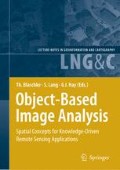Abstract
Object-based image analysis often uses image segmentation as a preliminary step to enhance classification. Object-based classification therefore relies on the quality of the segmentation output. This study evaluates the relevance of quantitative segmentation quality indices to object-based classification. Image segmentation is expected to improve the thematic accuracy of classification but the counterpart is an increased chance of boundary artefacts. Goodness indices were used to assess the former while discrepancy indices evaluated boundary quality. Inter-class Bhattacharyya distance was used to test the relevance of the goodness indices. The results showed that the use of global goodness indices, which did not require a priori information about the study area, was relevant in the case of object-based classification. In this context, the goodness index based on intra-class standard deviation was more useful than the one based on mean object size. On the other hand, it was shown that object size improved class discrimination but this could deteriorate the boundary quality. The use of complementary discrepancy indices is therefore required in the case of frequent under-segmentation.
Access this chapter
Tax calculation will be finalised at checkout
Purchases are for personal use only
Preview
Unable to display preview. Download preview PDF.
References
Almeida-Filho R, Shimabukuro YE (2002) Digital processing of a Landsat-TM time series for mapping and monitoring degraded areas caused by independent gold miners, Roraima state, Brazilian Amazon. Remote Sensing of Environment, 79:42-50.
Baatz M, Schäpe A (2000) Multi-resolution segmentation – an optimization approach for high quality multi-scale segmentation. In: Strobl, J et al. (Hrsg.): Angewandte Geographische Informationsverarbeitung XII, 12-23. Beiträge zum AGIT Symposium Salsburg 2000, Karlruhe, Herbert Wichmann Verlag.
Carleer AP, Debeir O & Wolff E (2005) Assessment of very high resolution satellite image segmentations. Photogrammetric Engineering and Remote Sensing, 71(11), 1284-1294.
Definiens Imaging GmbH (2002) eCognition user guide. Definiens Imaging GmbH, Munich, Germany.
Edwards AWF, Cavalli-Sforza, LL (1965) A method for cluster analysis, Biometrics, 21: 362-375
Foody GM (2002) Status of land cover classification accuracy assessment. Remote Sensing of Environment, 80:185-201.
Guigues L, Cocquerez J-P, Le Man H (2006) Scale-set image analysis. International Journal of Computer Vision, 68(3):289-317
Hay GJ, Marceau DJ, Bouchard A, Dubé P (2001) A multiscale framework for landscape analysis: object-specific up-scaling. Landscape Ecology, 16: 1-19
Hay GJ, Blaschke T, Marceau DJ, Bouchard A (2003) A comparison of three image-object methods for the multiscale analysis of landscape structure. ISPRS Journal of Photogrammetry & Remote Sensing, 57:327-345.
Inglada J (2005) Use of pre-conscious vision and geometric characterizations for automatic man-made object recognition. Proceedings of the International Geoscience And Remote Sensing Symposium 2005. Seoul, Korea.
Jung CR (2007) Combining wavelets and watersheds for robust multiscale image segmentation. Image and Vision Computing, 25:24-33
Leckie DG, Gougeon FA, Walsworth N, Paradine D (2003) Stand delineation and composition estimation using semi-automated individual tree crown analysis. Remote Sensing of Environment, 85:355-369
Lobo A, Moloney K, Chiariello N (1998) Fine-scale mapping of a grassland from digitized aerial photography: an approach using image segmentation and discriminant analysis. International Journal of Remote Sensing, 19(1): 65-84
Marr D (1982) Vision: a computational investigation into the human representation and processing of visual information. WH Freeman and Company, NY pp 29-61
Möller M, Lymburner L, Volk M (2007) The comparison index: A tool for assessing the accuracy of image segmentation. International Journal of Applied Earth Observation and Geoinformation 9:311–321
Mowrer HT, Congalton RG(Eds) (2000) Quantifying Spatial uncertainty in natural resources : Theory and application for GIS and remote sensing, Ann Arbor Press, Chelsea, Michigan, 234 p
Munoz X, Freixenet J, Cufi X, Marti J (2003) Strategies for image segmentation combining region and boundary information. Pattern recognition letters 24:375-392
Pal NR, Pal SK (1993) A review on image segmentation techniques. Pattern recognition 26, 1277-1294
Pekkarinen A (2002) Image segment-based spectral features in the estimation of timber volume. Remote Sensing of Environment, 82: 349-359
Radoux J, Defourny P (2005) Accuracy assessment of forest stand delineation using very high spatial resolution satellite images. ForestSAT 2005 Proceedings, Boras, pp 84-89
Soille P (2000) Morphological image analysis: Principles and applications. Springer, Berlin Heidelberg New York
Stehman SV (1997) Selecting and interpreting measures of thematic classification accuracy. Remote Sensing of Environment, 62: 77-89
Webb A (2002) Statistical pattern recognition. Wiley and sons, West Sussex, England
Wulder MA, Skakun RS, Kurz WA, White JC (2004) Estimating time since forest harvest using segmented Landsat ETM+ imagery. Remote Sensing of Environment, 93:179-187
Zhan Q, Molenaar M, Tempfli K, Shi W (2005) Quality assessment for geo-spatial objects derived from remotely sensed data. International Journal of Remote Sensing 26:14 2953-2974
Zhang YJ (1996) A survey on evaluation method for image segmentation. Pattern recognition 29(8): 1335-1346
Zhang YJ (1997) Evaluation and comparison of different segmentation algorithms. Pattern recognition letters 18: 963-974
Author information
Authors and Affiliations
Editor information
Editors and Affiliations
Rights and permissions
Copyright information
© 2008 Springer-Verlag Berlin Heidelberg
About this chapter
Cite this chapter
Radoux, J., Defourny, P. (2008). Quality assessment of segmentation results devoted to object-based classification. In: Blaschke, T., Lang, S., Hay, G.J. (eds) Object-Based Image Analysis. Lecture Notes in Geoinformation and Cartography. Springer, Berlin, Heidelberg. https://doi.org/10.1007/978-3-540-77058-9_14
Download citation
DOI: https://doi.org/10.1007/978-3-540-77058-9_14
Publisher Name: Springer, Berlin, Heidelberg
Print ISBN: 978-3-540-77057-2
Online ISBN: 978-3-540-77058-9
eBook Packages: Earth and Environmental ScienceEarth and Environmental Science (R0)

